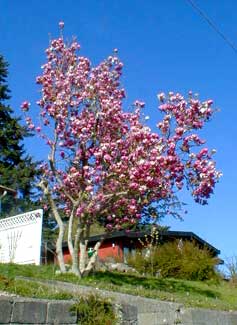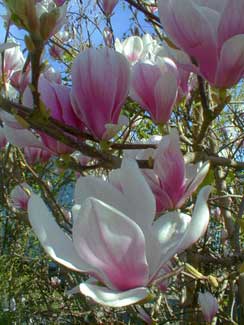
Magnolia Tulip Tree; or,
Saucer Magnolia
"Am I in your ear still singing songs in the rain,
me of the death rattle, me of the magnolias,
me of the sawdust tavern at the city's edge. "
-Anne Sexton
(1928-1974)
(1928-1974)
The Magnolia Tulip Tree or Saucer Magnolia runs neck in neck with the Royal Star Magnolia as the most commonly seen magnolia in Northwest landscapes. The photos on this page are from two of three tulip magnolias within two blocks of our home. They aren't ours, but by right of being nearby, we get to enjoy them.
 There's a sad & guilt-ridden nostalgia associated by me with this species. When I was little, my great-grandma Elva planted a tulip magnolia & each year it bloomed there'd be a spring garden party in her front yard for everyone to gape at what was evidently the favorite of Gramma's many flowering shrubs & trees.
There's a sad & guilt-ridden nostalgia associated by me with this species. When I was little, my great-grandma Elva planted a tulip magnolia & each year it bloomed there'd be a spring garden party in her front yard for everyone to gape at what was evidently the favorite of Gramma's many flowering shrubs & trees.One day I was hanging by my hands from the lowest branch. It was not a big mature specimen, so it did not have a great many branches, so could not easily lose one & still look pretty much the same. When it snapped right off at the trunk. I burst into breathlessly hysterical tears & ran inside to tell Gramma I killed her favorite tree. She immediately took me outside to look at it & reassured me it would be okay.
I frankly would never plant this tree in a garden of my own, not so much because it is already over utilized in our area (which it is), but because decades later I still don't like to be reminded how I injured Grandma Elva's young tree.
An heirloom dating to the 1820s, Magnolia x soulangiana originated as a hybrid of two Asian native magnolias, China's ivory-white Yulan Magnolia (M. denudata, formerly M. conspicula, M. yulan & M. heptapeta) pollinated by Japan's Lily Magnolia (M. quinquepeta, formerly M. liliiflora & M. purpurea). It was named after Etienne Soulange-Bodin (1774-1846), a Napoleonic soldier who survivved the defeat at Waterloo, & who afterward became director of The Royal Institute of Horticulture near Paris, where he raised his hybrid seedlings. He first saw his hybrids flower in 1827 & knew at once that he had something.
They grow to 25 feet or so in height & almost always have more than one trunk. Some are giant shrubs with dozens of upright limbs, but it is common to see them with three or four much more substantial trunks, or a single trunk that splits into three after the first three or four feet. If not trained to develop a thick trunk, it will of its own accord be a rounded multistemmed shrub.
They are extremely robust & flowerful for Northwest gardens, & flourish anywhere in zones 7 through 9. They will survive down to zone 4, though without such reliable flowering since the buds frequently freeze off.
Winter's fuzzy pussywillow-like buds open into mildly fragrant blossoms in mid-March before these deciduous trees releaf. On a well-established tulip tree the branches can nearly vanish amidst the enormous white & purply-pink blossoms. Even small specimens bloom well.
The flowers are said to resemble tulips, & on many cultivars they do, but for the cultivars 'Superba' & 'Alexandrina,' each "tulip" petal more resemble a donkey's ear, with a bend or a curl or otherwise a mite floppy, so not quite the perfect tulip-shape cups that open into flat saucers, as seen on forms with shorter rounder petals.